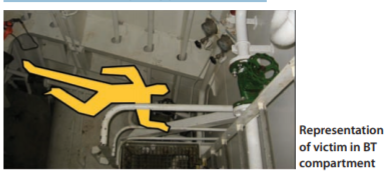202058 Bow thruster compartment fatality
As edited from official MSIU (Malta) report 15/2018
A tanker had discharged cargo and crew were ballasting at berth in preparation for departure and a voyage in ballast. During ballasting, the bilge high level alarm sounded for the bow thruster compartment and a crew member was sent forward to investigate. Proceeding down to the bosun’s store level, he immediately noticed water escaping from the forepeak tank manhole. This water had reached the bow thruster compartment entrance and was flowing over the sill plate and cascading on the bow thruster motor below. The situation was reported to senior officers and the ballasting operation was stopped.
The ship’s electrician was to inspect the bow thruster motor for any water damage. The bow thruster’s electrical supply was isolated and two crew members made their way to the bow thruster compartment for the initial assessment of the condition. The motor was sprayed with electrical cleaner and then the workers exited the space for coffee break. Some time later the electrician returned alone to continue the work on the bow thruster motor. The second crew member arrived about 15 minutes later. He saw the electrician lying face down in the bow thruster compartment. He called out to him, but there was no response. He initiated the emergency response and the Master and others soon arrived on scene.
The Master climbed down to the victim, who remained unresponsive. He then had to exit due to the strong smell of chemicals. In the meantime, the ship’s rescue team had mustered. They donned breathing apparatus (BA) sets and climbed down into the bow thruster compartment. It then become evident that it would not be possible to recover the electrician from the bow thruster space so the local Civil Protection Department was called to assist. About one hour after first being discovered the electrician was recovered from the space. However, he was subsequently pronounced dead.

Some of the findings of the official report were:
- At the time of the accident, the bow thruster compartment’s characteristics were similar to those of an enclosed space without being declared as such. l The isolation of the bow thruster compartment’s electrical supply resulted in the ventilation of that space being switched off, compromising the supply of fresh air inside. l Although the autopsy was not available to investigators, suffocation due to lack of oxygen was deemed the most probable cause of this accident.
Lessons learned
- Some spaces, although not officially an enclosed space, can assume those same dangerous characteristics if certain conditions are present – especially lack of air circulation.
- NEVER rush into a space that has a collapsed crew member inside. Muster the emergency team and enter with BAs.
- Practise confined space emergency procedures on a variety of compartments on your ship to determine which ones will be problematic.
